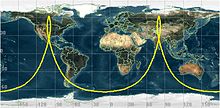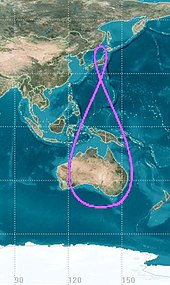Highly elliptical orbit

A highly elliptical orbit (HEO) is an elliptic orbit with high eccentricity, usually referring to one around Earth. Examples of inclined HEO orbits include Molniya orbits, named after the Molniya Soviet communication satellites which used them, and Tundra orbits.
Such extremely elongated orbits have the advantage of long dwell times at a point in the sky during the approach to, and descent from, apogee. Bodies moving through the long apogee dwell appear to move slowly, and remain at high altitude over high-latitude ground sites for long periods of time. This makes these elliptical orbits useful for communications satellites.
Geostationary orbits cannot serve polar latitudes because their elevation above the horizon from these ground sites is too low.[1] The latitude limit for a GEO sat is 81 degrees with a practical limit of just above 75 degrees.[2] Many GEO comm sats have custom "foot prints" and focus their signals at their primary service areas, so above 60 degrees a larger ground antenna and clear line of sight is needed.


Sirius Satellite Radio used inclined HEO orbits, specifically the Tundra orbits, to keep two satellites positioned above North America while another satellite quickly sweeps through the southern part of its 24-hour orbit. The longitude above which the satellites dwell at apogee in the small loop remains relatively constant as Earth rotates. The three separate orbits are spaced equally around the Earth, but share a common ground track.[3]
References[edit]
- ^ Fortescue, P.W.; Mottershead, L.J.; Swinerd, G.; Stark, J.P.W. (2003). "Section 5.7: highly elliptic orbits". Spacecraft Systems Engineering. John Wiley and Sons. ISBN 0-471-61951-5.
- ^ https://www.planetary.org/space-images/coverage-of-a-geostationary
- ^ "The Tundra Orbit". Canadian Satellite Tracking and Orbit Research (CASTOR). 23 May 2010. Retrieved 2 October 2017.
